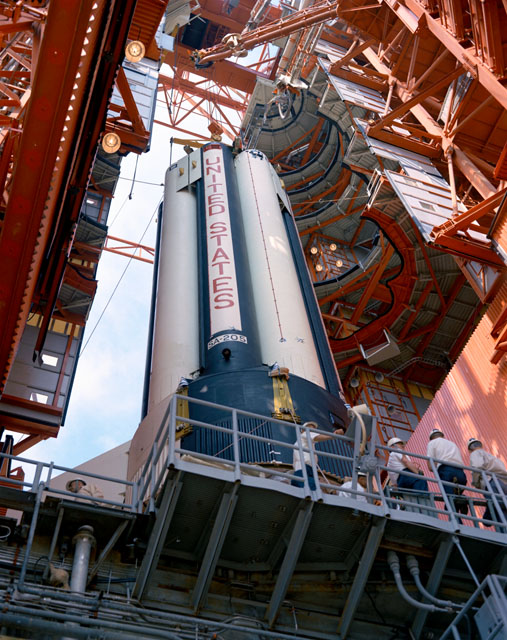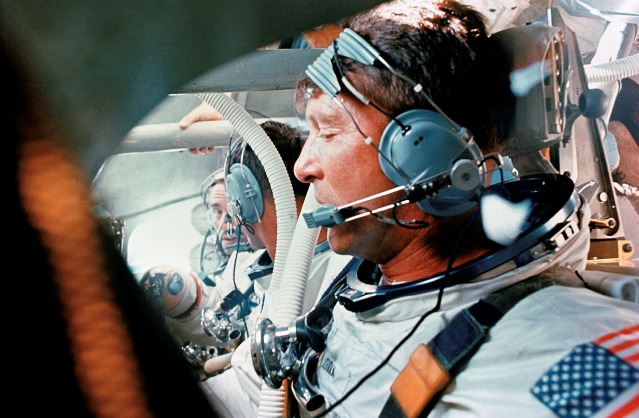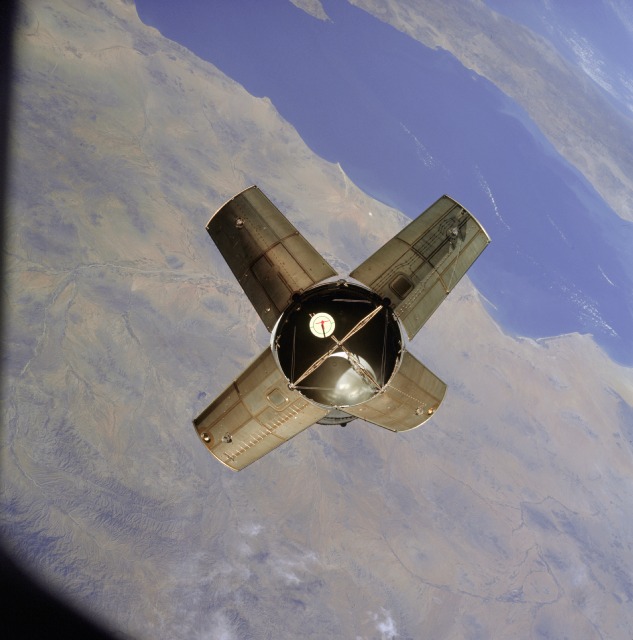
Five decades ago, a gigantic rocket—nicknamed “the big maumoo” by Apollo 7 Commander Wally Schirra—stood primed on Pad 34 at Cape Kennedy, ready to launch the first stepping-stone in America’s bid to land a man on the Moon before the end of the 1960s. Powered by eight H-1 engines on its S-IB first stage and a single J-2 engine on its S-IVB second stage, the Saturn IB had previously flown in an unmanned capacity on three occasions in 1966, after which it was primed to deliver its first human crew into low-Earth orbit on the Apollo 1 mission in the spring of the following year. However, astronauts Virgil “Gus” Grissom, Ed White and Roger Chaffee were tragically killed in a ground-based test aboard Apollo 1 and “their” Saturn IB ended up being used to loft the first Lunar Module (LM) into low-Earth orbit in January 1968.

On its fourth outing, 50 years ago, this week, the Saturn IB would be entrusted with its most vital endeavor to date: not only safely launching a crew into space, but also reinvigorating America’s human space program and bringing the lunar goal back into focus. In fact, by the time Wally Schirra and his Apollo 7 crewmates, Donn Eisele and Walt Cunningham, returned from space, the success of their mission would allow NASA to press ahead with an audacious plan to send Americans to the Moon on Apollo 8.
https://www.youtube.com/watch?v=HNY2yKBPn9w
Video Credit: CBS News
By the time they launched on 11 October 1968, Schirra, Eisele and Cunningham had spent an estimated 600 hours in the Command Module (CM) simulator, operating 725 manual controls and responding to numerous simulated malfunctions. They had tested the Chrysler-built slidewire—which would whisk them to safety in the event of an emergency evacuation from Pad 34—and had crawled out of a mockup of their ship in the Gulf of Mexico. They had also pored over hundreds of pages of documentation and flight plans. In theory, Apollo 7’s test objectives could be accomplished in as little as three days, but according to Apollo Program Director Sam Phillips was “open-ended” to 11 days to permit the collection of “additional data and evaluate the aspects of long-duration spaceflight”.

The countdown to launch was punctuated by three built-in holds and got underway on 6 October. Operations ran exceptionally smoothly, but as launch on the 11th neared, a problem reared its head. Just ten minutes prior to the scheduled 11 a.m. EDT liftoff, with Schirra, Eisele and Cunningham strapped into their couches aboard the spacecraft, thrust-chamber jacket chilldown was initiated for the Saturn IB’s second stage. This took slightly longer than anticipated to complete and forced a hold of two minutes and 45 seconds. The countdown resumed at 10:56 a.m. EDT and Apollo 7 roared aloft at 11:02:45 a.m. EDT, watched by 600 accredited journalists.
Inside the CM, the crew experienced a clear sense of motion, but only Eisele could see anything of what was going on outside. “We had a boost-protective cover over the command module,” Cunningham recalled later in a NASA oral history. “There’s an escape rocket that you can use any time until you get rid of it, and that’s a little after a minute into the flight. Because that rocket puts out a plume, you had to have a cover over the command module, so that you wouldn’t coat the windows and you wouldn’t be able to see anything out of the windows in the event you were coming down on a parachute during an abort. So, the only place you can see out is over Donn’s head in the center seat. There’s a little round window, about six inches across, and he was the only one that could see out.” Schirra and Cunningham, by contrast, had no outside view until the boost-protective cover was finally jettisoned, a few minutes into flight.

Two and a half minutes into ascent, the eight H-1 engines of the S-IB first stage burned out and it was discarded, allowing the S-IVB second stage to pick up the thrust and deliver Apollo 7 into low-Earth orbit. A little under six minutes after departing Cape Kennedy, Schirra reported that the Saturn IB was “riding like a dream”.
On the ground, however, circumstances were not quite so dreamy. For a minute or so during ascent, the Manned Spacecraft Center (MSC) in Houston, Texas, suffered a power failure, which temporarily knocked out lights, control consoles, screens and instruments. Fortunately, generator power took over and no telemetered data was lost.

Ten and a half minutes after launch, Apollo 7 was inserted perfectly into orbit and S-IVB shut down on time. Both stages of the Saturn IB had performed near-perfectly on the rocket’s first flight with humans aboard. Two hours and 55 minutes into the flight, the spacecraft undocked from the second stage and pulsed its reaction-control thrusters twice to effect a simulated rendezvous, which lunar-bound astronauts would use to collect their Lunar Module (LM) from the S-IVB.
Although there was no lunar module aboard Apollo 7, the exercise provided useful practice and Schirra brought his ship within 5 feet (1.5 meters) of the spent rocket. Unfortunately, said Cunningham, one of the four adapter panels had not fully deployed, due to a stuck retention cable, although they would be jettisoned explosively on later missions to ensure LM extraction. It had been a successful start to what would prove a hugely successful—though not uncontroversial—mission.
FOLLOW AmericaSpace on Facebook and Twitter!
.
Missions » Apollo »





The run up to the launch was magnificently captured in the episode “We Have Cleared the Tower” from “From the Earth to the Moon”. Mark Harmon played Wally Schirra perfectly.
Wally was being rather difficult before and during the mission because, as he said years later, he was terrified. Gus Grissom was a friend and next door neighbor in Houston and his death shook Wally badly. His head cold didn’t help matters at all.